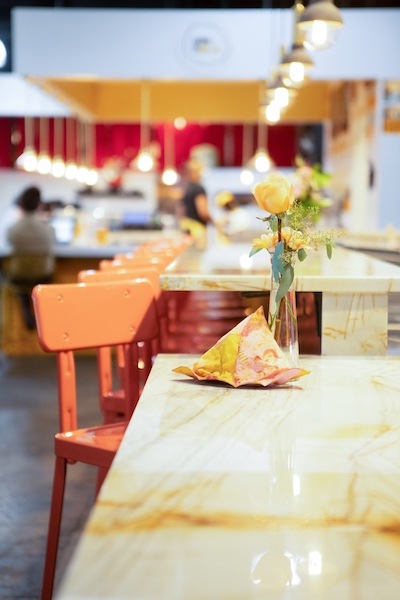
The Case for Considering a Food Hall Concept
ICE Chef Palak Patel explains how she developed her new business.
ICE Chef Palak Patel moved home to Atlanta in 2020 and launched food hall concept Dash & Chutney at Chattahoochee Food Works.
In March of 2020, lots of things changed for me in a drastic way, including my first restaurant concept planned for Hudson Yards. Like many, I was in the midst of business as usual in New York and eager for the grand opening of Little Pea, my plant-based Indian-inspired concept located on Manhattan’s west side. A better part of two years went into honing the concept, finding a space, understanding the landscape of commercial real estate, recipe testing, securing investors and ultimately saying yes to the project.
The pandemic changed everything in an instant. I left New York on March 14, stayed with my parents in Atlanta for what I thought was going to be three weeks. Little did I know that would extend until September. During those weeks and months, investors started backing out one by one and by the middle of summer, I was left wondering, what’s next?

In July, I decided to walk away from the Hudson Yards project and rethink my restaurant concept. It was clear that my project in New York was not going to happen. During my time in Atlanta, I had the opportunity to explore the food scene and conceptualize what this market needed. Like many major metropolitan cities around the world, food halls have gained popularity here. First, Krog Street Market opened in Atlanta near the BeltLine, delighting residents with an array of unique international food options. Then came Ponce City Market, the fast-growing, wildly successful, novel food hall in a converted former Sears building from the 1920s.
Clearly, food halls are doing well in Atlanta, and now I got an opportunity to launch a concept at one of them: Chattahoochee Food Works, a 25,000-square-foot food destination in Atlanta’s Upper Westside that’s backed by famed chef Andrew Zimmern along with Robert Montwaid, creator of the Gansevoort Market in New York City. At first, this seemed like a good pivot for me, but I didn’t really understand the economics of running a food hall concept.
Food halls are usually highly curated without the fast-food chains that are typically found in food courts. Food halls are popping up in New York and around the globe, offering eaters an array of quickservice food operators, casual dining restaurants, outposts of well-known brands and smaller independent concepts in large spaces. The groups who develop these food halls are just as varied and include restaurateurs, commercial real estate investors and experienced entrepreneurs. One destination with a variety of food choices can appeal to anyone and provide a new way of dining out. For chefs, it's a foray into a new market without the cost of a brick and mortar. The communal nature of the food hall allows groups to partake in a joint experience at an affordable price point.
I’ve always enjoyed going to food halls in cities where I traveled or lived in, and now I had an opportunity to pivot my concept. I had to study the business model and get a thorough understanding of the operations. Here are things to consider when opening in a food hall.

Developing a Food Hall Concept
Not all concepts that work in a dine-in restaurant translate to food halls. My concept at Hudson Yards, which was a seated restaurant, would not work in a food hall. So, I created something that does: an Indian street food concept that is completely plant-based, called Dash & Chutney. Food halls have limited prep and serving space, require fast service and compete with neighboring concepts to consider when designing the menu. Differentiate your concept to stand out because that is key in a busy food hall. Instead of having a lengthy menu, think of smaller, signature menu items. Less is more in a food hall. Balance the menu with easy-to-prep items and execute dishes quickly.
Location
The newness of Chattahoochee Food Works along with the large influx of city and private funding for expansion made this location ideal for my project. Take time to research city plans, short-term and long-term, to gauge the development of the surrounding areas. It’s important to weigh both where the food hall is located in a city and where the actual food stall is within the venue when launching a concept. Foot traffic is the name of the game in this ecosystem, so identify where potential business is coming from — commercial, residential or destination. Opt for heavier foot traffic areas when looking for a stall. Scope out all other concepts and operators — the food hall is only as strong as the operators.
Funding
The benefit of opting for a food hall versus a traditional dine-in restaurant is the lower cost of entry. Unlike a traditional restaurant where start-up investment can range from $250,000 to $500,000, a food hall may require anywhere from $100,000 to $200,000. The investment varies based on the size of the booth and the finishes, but it is much less expensive to launch. Lower labor, buildout and operational costs make food halls ideal for testing new concepts.
Operations
Food halls' hours of operations are typically seven days a week with an earlier closing time than restaurants. Typically, owners are required to operate 10 hours a day, seven days a week. Using point-of-sale software to track items that sell well and adjusting recipes to accommodate customer tastes is a little easier in a food hall.
Lease Terms
A primary difference between restaurants and food halls is the structure of the lease agreement. My NYC restaurant lease was for 10 years compared to two years at this food hall. This is a huge benefit to test out a concept without the liability of a longer lease.
Food hall leases often have a percentage sales clause that charges rent plus a percentage of gross sales or only a percentage of gross sales. Others may charge triple the net rent, which requires tenants to pay rent as well as property taxes, property insurance premiums and maintenance costs. It is really important to understand the lease before signing. Percentages can vary from 5% to 10%. There are also communal charges (called CAM), in addition to rent, for security, grease traps, insurance and other miscellaneous upkeep for the food hall. Ideally, the lower the percentage rent, the better the deal.
For chefs and restaurateurs who are looking for a pivot, food halls may be an easier option for entry and a way to avoid long-term commitments. This business model made sense for me and many others in the industry.
Learn more about the food business in ICE's Restaurant & Culinary Management program.


Add new comment